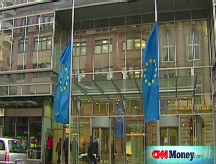Bank-to-bank lending eases
Three European central banks slash interest rates, and lending rates ease further. Debt prices remain at record levels.
NEW YORK (CNNMoney.com) -- Bank-to-bank lending rates continued to march lower, as a trio of European central banks slashed their key interest rates, a move that markets had largely expected.
However, exceptionally low government debt yields show that investors fueled by fear of the volatility in global stock markets were still flocking to Treasurys.
Government debt prices remained near record high levels, and yields were at record lows. The yield on the 3-month T-bill hovered very close to 0% for most of the trading session.
"People don't want to buy anything but Treasurys because that is where the safety is," said Mary Ann Hurley, vice president of fixed income trading at D.A. Davidson.
The 3-month Libor rate fell for the third day in a row Thursday, to 2.19% from 2.20% Wednesday, according to Bloomberg.com. The three month bank-to-bank lending rate has fallen 0.01% each day since Monday, when the rate sat at 2.22%.
The overnight Libor rate fell for the fourth day in a row Thursday, to 0.52% from 0.88% Wednesday. The overnight lending rate was at 1.16% Friday.
Libor, the London Interbank Offered Rate, is a daily average of what 16 different banks charge other banks to lend money in London, and is used to calculate adjustable-rate mortgages. More than $350 trillion in assets are tied to Libor.
European banks slash rates: In an effort to mitigate the recession in Europe and get credit moving freely again, the European Central Bank, the Bank of England and the Swedish Riksbank all cut their key lending rates.
Central banks around the globe have been working for months to unclog frozen lines of credit. "They are doing everything they can in their powers to create liquidity in the system, to create lending, movement of money - not only between banks but from banks to customers," said Hurley.
Despite these efforts and gradually improving Libor rates, though, it will take time for the global credit markets to return to health, Hurley said. "It is going to be something that slowly happens as banks get their balance sheets in order and as confidence grows between the lending institutions," said Hurley. "I don't see it happening in one fell swoop but I do expect it to improve over time."
The Bank of England noted in the statement that was released with its decision to move the key lending rate to 2% from 3% that credit remained tight, and it would be a while before the system was healthy again.
"Despite the actions taken to raise bank capital, ease funding and improve liquidity, conditions in money and credit markets remain extremely difficult," the Bank of England said. "The Committee noted that it was unlikely that a normal volume of lending would be restored without further measures."
Market gauges: Two bond market gauges were little changed Thursday.
The "TED spread" widened to 2.18 percentage points, up slightly from 2.17 percentage points late Wednesday. The TED spread measures the difference between the 3-month Libor and the 3-month Treasury bill, and is a key indicator of risk. The higher the spread, the more unwilling investors are to take risks.
Another indicator, the Libor-OIS spread, widened to 1.86 percentage points from 1.82 percentage points Wednesday. The Libor-OIS spread measures how much cash is available for lending between banks, and is used for determining lending rates. The bigger the spread, the less cash is available for lending.
Treasurys: Government debt prices rallied Thursday, and yields were still at record lows, indicating continued investor anxiety.
Debt prices "are extremely elevated, and in order to continue these levels you have to have sustained bad economic news," said Hurley, or believe "that the Fed is going to continue easing" its key lending rates, she said.
Also adding to investor unease: AT&T, DuPont, Viacom and Credit Suisse Group Thursday announced a total of 20,650 job cuts because of the weak economy and the auto industry pleaded their case for bailout funds on Capitol Hill.
Bond prices and yields move in opposite directions. Treasurys are perceived as one of the safest places for investors to keep their assets in times of economic uncertainty, and higher prices signal a flight to safety.
The price on the benchmark 10-year note rose 1-1/32 to 110-16/32 and its yield fell to 2.55% from 2.67% late Wednesday. Last week, the 10-year yield fell below 3% for the first time since the note was first issued in 1962.
The 30-year bond jumped 1-31/32 to 127-15/32 and its yield slipped to 3.08% from 3.17% late Wednesday, which was an all-time low closing point for the 30-year bond.
The 2-year note rose 4/32 to 100-27/32 and its yield fell to 0.84% from 0.90%.
The yield on the 3-month note fell to 0.01% from 0.02% late Wednesday. That bill is closely watched as an indicator of investor confidence. Investors and money-market funds shuffle funds in and out of the 3-month bill frequently, as they assess risk in the rest of the marketplace. A higher yield indicates that investors are slightly more optimistic.
The government has been auctioning off a lot of government debt to pay for its massive financial bailout program. ![]()





